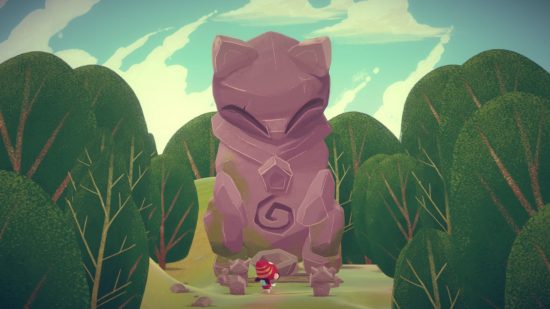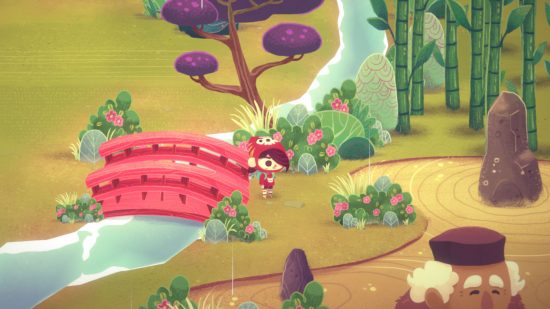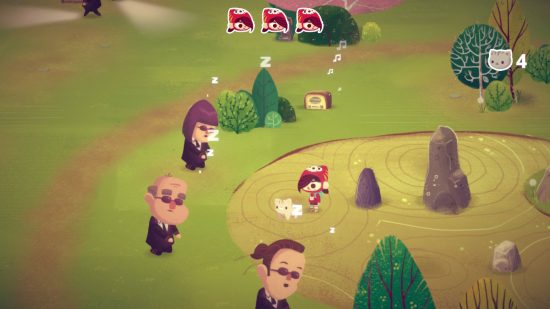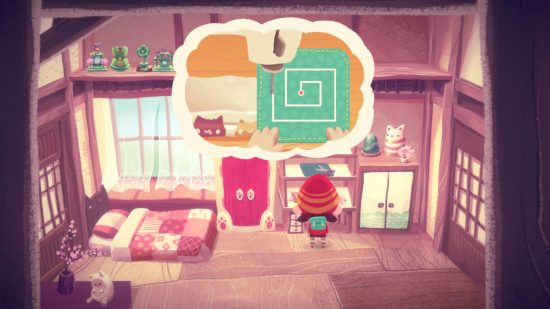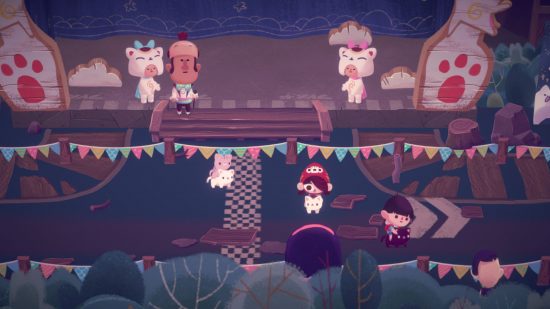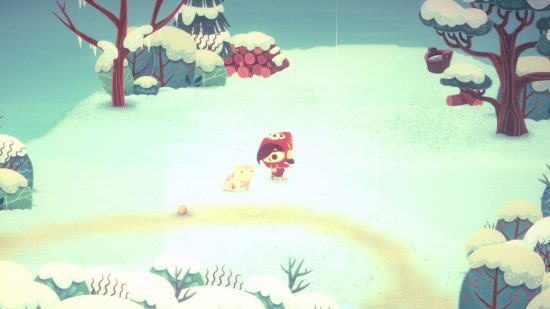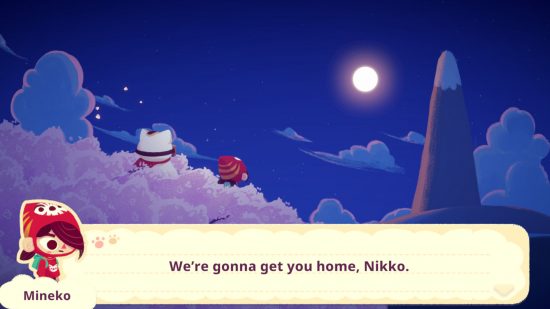Our Verdict
Mineko’s Night Market is a truly charming little game, full of cute cats, quirky characters, and plenty of chill vibes. Its narrative successfully celebrates Japanese culture, friendship, and belonging in such a beautiful way, and is supported by a simple yet engaging gameplay loop made up of gathering, crafting, and even a spot of espionage. A must for cozy game lovers all over the world, and the perfect way to unwind after a stressful day.
Mineko’s Night Market has been on my radar for a long time – over two years, in fact. Back when I first started working on Pocket Tactics, I remember falling in love with my first glimpses of the game and telling my team that I would love to review it when the release date came around. So it feels pretty satisfying to sit here after so much time has passed, finally able to dive into a Mineko’s Night Market review.
But, with a long wait comes a build-up of anticipation and expectations – so does the game live up to the hype? Well, I may be a tad biased due to Mineko’s Night Market checking most of my boxes, but I genuinely love this game. It’s simple and charming, with a fun sense of humor, a touching narrative, and a relaxing yet engaging gameplay loop, all making for a very enjoyable little title with heaps of personality.
Mineko’s Night Market describes itself as a narrative-driven, social simulation adventure that celebrates Japanese culture, and it certainly delivers on that front. The story follows a young girl called Mineko, who moves to a small island with her dad. However, there are strange goings on happening on this island – and she soon finds herself in the middle of it all.
The island was once populated by many cats, as well as the Sun Cat, Nikko – a giant cat who lived atop Mt. Fugu and watched over the people below. However, with Nikko seemingly gone, the island is now a shell of its former self, and many of its inhabitants don’t even believe he exists – that is, except for Bobo, who immediately befriends Mineko and invites her to help prove Nikko’s existence.

Finding evidence of Nikko and returning the island to its former glory isn’t an easy task, as there are heaps of mysterious agents poking around – and they’ve even captured all the cats in cages. But one night, Nikko visits Mineko, and she embarks on a mission to not only free all the captured cats and help build the island back up, but to also help Nikko return to his home on top of Mt Fugu.
The narrative is utterly adorable, and I absolutely love the references to Japanese mythology throughout. The characters are also wonderful, from adults like Mineko’s dad and Hank the Hunk to the other kids like the initially antagonistic Miyako and boyband-obsessed Hana. The dialogue you share with them is charming and even insightful at times, with playful quips and jokes, sweet little anecdotes, and endearing backstories. There are also some truly moving moments throughout, exploring themes of friendship and belonging in a really touching way.
The main gameplay revolves around a weekly calendar. Throughout the weekdays, you can explore different areas, collect resources, craft items, and complete quests. On Saturday evenings, it’s time for the titular Night Market, where you sell your wares and take part in events to increase the market’s level and, ultimately, help it flourish into the iconic attraction it used to be.
You travel to different locations by going to the bus stop outside of your house. There isn’t a usual clock, so you can spend as much time in each area as you like, but time passes when you return from a location. Buses only run during the day and evenings, so you can visit a maximum of two locations a day, but you can explore them and gather items to your heart’s content, as long as you have the stamina for it.
Speaking of stamina and hearts, you only have one heart’s worth when you start the game. Harvesting or collecting items takes a set amount of stamina, from picking up a hairball or a flower, to chopping wood or mining rocks. You can eat or drink in order to restore stamina, with drinks and small snacks generally giving you half a heart and larger meals like yakisoba or sushi to-go giving you a full heart, but you can only eat or drink three items a day – so generally it’s best to splash out and buy the to-go meals rather than the cheaper ramune.
This feels a little restrictive at first, but as you progress through the story, you gain additional hearts so you can complete more tasks in a day. Also, each consumable gives you a cute little message when you use it, which is a nice added detail.
Usually, on your first visit to a new location, it’s infested with agents – and a few of the locations require you to have bought a tool from Hank’s Tool Shop before you can go there at all. Once you arrive, in order to unlock the location fully and progress further, you need to get past the agents, free a set amount of captured cats, and then complete a final task such as locating a Nikko artifact, disconnecting a comms tower, or destroying a supply crate.
In these sections, you have three ‘lives’ (noted by little Mineko head icons at the top of the screen). If you step in front of an agent’s flashlight, you lose a ‘life’. If you lose all three ‘lives’, you have to start the sequence again. Getting past most of the agents is generally a case of timing – wait until they move out of the way, then sprint through to get to the caged cat. However, there’s some variation that requires a bit of puzzle-solving or even bribery.
While these sections are all the same at their core, they still offer enough variety that you sometimes need to stop and think, and I find them very enjoyable. You also get a very satisfying moment when you manage to free all the cats and push the agents out of the area, allowing you to see it with all its flowers, resource points, and kitties out in the wild again. Oh, and how could I forget? Each location generally has a bunch of cats sitting around. And, yes, you can pet them – it doesn’t even cost any stamina to do so.
Some kitties just change position when you pet them, while others follow you around in a cute little kitten conga line until you leave the area and go home. The follower kitties sometimes get in the way, especially if you’re collecting items off the floor, meaning you may end up petting a cat rather than collecting an item – but honestly, as a cat mom, that’s pretty much my real life anyway, and due to the lack of stamina required to pet cats and there being no time limit in each location, there’s really no harm done.
Outside of picking items up on the floor, such as flowers or hairballs, the resources you collect each have their own sort of minigame. For example, mining rocks and chopping trees requires you to hit a button at the right moment, hold it, and release it when the marker is in the right place.
Fishing is another simple, quick-time-esque gathering game, where you need to wait until the fish pulls the lure down, then hit the button to real. Pretty much every resource you gather is useful for crafting, but you can also submit certain items to museums. Once you submit enough items, the museums get a makeover and open to the public, once again helping the island to expand and earning you some nice items.
Similarly, different crafting benches have their own minigames, too. These range from simple – such as hitting a button when the marker is hovering over the right section to cut a stem on the flower craftbench – to a bit more complex – such as guiding a paint brush around a map on the art craftbench or following a pattern with a sewing machine on the sewing craftbench. If you pull it off perfectly, you get a perfect item, which is worth more money. If you do well but don’t get it exactly right, you get a normal item. And, if you completely mess up, you get a garbage item that isn’t worthy of selling at all.
As mentioned earlier, the main purpose of crafting is to have stock to sell at the Night Market on Saturdays. However, you can also sell items at shops throughout the week if you need a bit of extra cash to buy some food, or a new tool or craftbench. You also get villager requests, where different characters ask for specific items – initially, these are usually food items, though later, they start asking for specific crafted items.
Completing village requests increases your relationship with the characters and is a great way to unlock new recipes or receive items. Though you can also unlock recipes through bottles that you catch while fishing, this is a nice incentive for you to cultivate friendships with the different characters around town, contributing to a nice level of world-building that feels very wholesome. It’s also very satisfying when you get the chance to give the villagers items that they then use to kit out their house, sprucing the island up even further.
When you get used to these different elements, it’s easy to fall into a comfortable rhythm, visiting certain locations throughout the week to top up your resources, crafting the items that sell the best, and then turning up to the market to make a big profit. But, with frequent new locations and story developments, this gameplay loop doesn’t get stale too quickly, and there’s always something new to do. However, if you prefer to take things slow, there’s no real time limit, either. So you can spend as many weeks as you want gathering and crafting before progressing on to the next part of the story.
Visually, Mineko’s Night Market is equally as beautiful. It adopts a simplistic, 2D picture-book aesthetic with lovely elements that nod to iconic Japanese artwork such as Hokusai’s The Great Wave off Kanagawa. The colors are varied yet somewhat muted, adding to the soft, relaxing vibe of the world, and everything feels like it’s washed in the golden light of a setting sun.
The music is also lovely, with unique, soothing tracks for the gathering locations and a jazzy, whimsical piece that backs up the espionage-esque sections with the agents, among others. Most of the pieces have a lo-fi vibe, and some even incorporate instruments reminiscent of classic Japanese music. It’s a lovely OST that truly enhances the relaxing nature of the game, and I could definitely imagine myself listening to it as I work in the future.
Outside of that, the sound design for the bulk of the game is unintrusive and fitting. The characters aren’t voiced at all, but to be honest, that doesn’t really detract from my enjoyment at all, especially as, combined with the large speech bubbles, it only seems to enhance the overall pop-up picture-book feel.
I was lucky enough to get my hands on both a Switch version and the Steam beta version, both of which I’ve tested thoroughly and played for hours. When it comes to controls, Mineko’s Night Market feels very intuitive on the Switch. Press one trigger to sprint and press the other to creep. One button for inventory, another for opening your journal, and another for collecting an item. It all feels comfortable and responsive, and I didn’t need to do any remapping for it to feel right.
The Steam version, on the other hand, took me a little while to get used to. While WASD works for movement, the default controls seem designed around using the directional arrows, as left shift is sprint and right shift is creep. You press enter to collect/interact with things, E to open your inventory, and J to open your journal, and the mouse doesn’t do anything at all. Luckily, you can remap the controls pretty easily through the settings menu, and after I got used to my new layout (left shift will always be sprint for me, it’s second nature at this point), I’ve come to find it comfortable and somewhat reminiscent of older PC games from back when I was a kid.
The performance on the Switch and Steam is mostly comparable. The simplistic art style and animations makes for a smooth and visually pleasing experience on both platforms for the most part, and screenshots even look comparable – which is a rarity for the Switch.
However, the Switch version does have some issues. Load screens are much longer, so you become very familiar with the running Mineko sprite on the bottom right corner. This is especially frustrating when you are going between the craft shop and tool shop in the village, as there’s a load screen for entering and exiting both of the shops, making the act take much longer than it needs to.
There’s also quite a bit of stuttering when you load into a new area or enter a cutscene, with the music cutting out and the characters sometimes freezing. These issues are essentially absent from the Steam version, so keep that in mind if choosing between platforms.
Outside of that, I experienced some bugginess in the HQ where, on the second floor, jumping into a vent to progress to the area where the door code was broken. I couldn’t progress, which meant I had to restart the game and lost my progress for the day. I also had a few buggy moments on the frozen lake, where Mineko would get caught on the corner of one of the frozen, slip-stream-esque sections, but it always worked itself out. This issue seems to be consistent across both the Steam and Switch versions. However, as this is a beta build, I’m cutting the game some slack here – and I have faith that the devs will fix these grievances in the full launch.
Overall, Mineko’s Night Market is a delightfully charming game, and, to me, it was well worth the wait. I know it’s cliche to say, but it really does emit the same coziness present in Animal Crossing games and Studio Ghibli films (specifically My Neighbor Totoro vibes), while also managing to pay homage to a beautiful culture and stand on its own two feet as a unique experience.
It’s simple and certainly doesn’t try to reinvent the wheel, but it’s also very relaxing and perfect for those days where the world feels a bit too much. So, if you’re having a rough time and feeling a bit blue, remember the Night Market is every Saturday, and Nikko is waiting for you.
Right, that’s it for our Mineko’s Night Market review. If this type of game is your vibe as much as it is mine, there are plenty of other titles to explore in our list of the best indie games, cute games, or our top picks for the best Switch games overall. We’ve also got a list of all the ACNH villagers, along with guides to Fae Farm multiplayer, Fae Farm flowers, and Fae Farm Fish.
